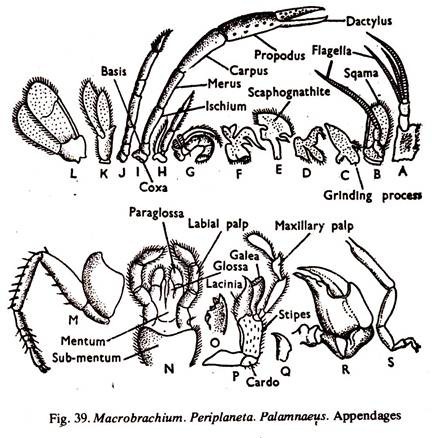Learn about the comparison of appendages in Macrobrachium, Periplaneta and Palamnaeus.
Comparison # Appendages of Macrobrachium:
1. Nineteen pairs of biramous appendages; five pairs in the head, eight pairs in the thorax and six pairs in the abdomen.
2. Antennules – Each consists of a three-jointed protopodite bearing three many jointed flagella at the distal end and a statocyst at the base.
Functions – Sensory and tactile.
ADVERTISEMENTS:
3. Antennae – Each consists of a two-jointed protopodite bearing a flat squama and a many jointed flagellum.
Functions – Tactile and balance.
4. Mandibles – The body is unjointed, bears teeth and masticatory lobes known as molar processes and a jointed mandibular palp on the outer surface.
Functions – Cutting and crushing of the food.
ADVERTISEMENTS:
5. 1st maxillae – Leaf-like, with two inner lobes acting as gnathobases and an outer lobe. Functions. Tearing and passing the food to the mouth.
6. 2nd maxillae – Leaf-like, with a flattened scaphognathite.
Functions – Masticatory and respiratory.
7. 1st maxillipeds – Leaflike protopodite with a whip-like exopodite and a slender endopodite. Functions. Respiratory, masticatory and sending the food to the mouth.
ADVERTISEMENTS:
8. 2nd maxillipeds – The protopodite with an epipo- dite bears a five-jointed endopodite, a whip-like unjointed exopodite and a gill. Functions. Respiratory.
9. 3rd maxillipeds – The protopodite bears a three- jointed leg-like endopodite and a slender unjointed exopodite. A small epipodite is present. Functions. Locomotory and respiratory.
10. Walking legs (pereo- pods) – Five pairs; each leg consits of seven podomeres or segments.
The first two legs end in chela and the second is the largest. The two basal segments represent the coxopodite and basipodite and the remaining five are ischium, merus, carpus, propodus and dactylus respectively, in order of succession.
Functions – Holding the prey and walking in first two, and only walking in the last three.
11. Abdominal appendages – Six pairs; each pleopod consists of a two-jointed protopodite bearing expodite and endopodite. In the second pleopod of male, an appendix mascu- lina, concerned with reproduction is found. In the second to fifth pleo- pods, appendix internae are present. Function. Swimming.
Appendix masculinae help in mating. Appendix internae form a basket in female to carry eggs.
12. Uropod – Protopodite small, the exo- and endopodite are broad and oval. With the telson it forms the powerful tail fin. Functions. Balance and back swimming with a jerk.
Comparison # Appendages of Periplaneta:
1. Seven pairs of appendages; four pairs in the head and three pairs in the thorax.
ADVERTISEMENTS:
3. Antennae – Each antenna is long, slender and many-jointed. Function. Sensory
4. Mandibles – The body is a strong chitinoid structure provided with teeth. Function. Cutting of food.
5. 1st maxillae – Each consists of a protopodite bearing a double endopodite having lacinia and galea and a five-jointed exopodite. The maxillary palp is supposed to represent the endopodite of crustacea. Functions. Holding and masticating the food and sensory.
6. 2nd maxillae – The pair fused to form a labium. The fused base form two sclerites, submentum and mentum. Mentum bears the prementum, which in turn carries an outer, paired and lobed structure, the paraglossae and an inner, paired and lobed glossae; together forming the ligula. Functions. Sending the food to the mouth and sensory.
10. Three paris of legs – Each leg consists of five segments, coxa, trochanter, femur, tibia and a six-jointed tarsus ending in a pair of claws. Function. Walking.
11. The anal cerci are possibly the relics of last abdominal appendages. Function. Tactile.
The styles of male and the gonapophyses are possibly relics of appendages.
Comparison # Appendages of Palamnaeus:
1. Six pairs of appendages; two pairs in the head and four pairs in the thorax.
4. Chelicerae – Preoral in position. The appendage is small, three-jointed, ending in a chela.
Function – Holding the prey.
5. Pedipalpi – Post-oral in position. It is a large, six-jointed structure ending in a great chela. Functions. Seizer of prey and mastication by the bases.
10. Four pairs of legs – Each leg consists of seven segments, the last one ending in a curved, pointed horny claw. The claw is absent in the 3rd and 4th pairs of legs. Functions. Walking but in the first and second pairs the bases help in mastication of food.
11. The operculum bearing the genital pore and the comb-like tactile pectines are probably the remnants of the first and second pairs of abdominal appendages respectively.
